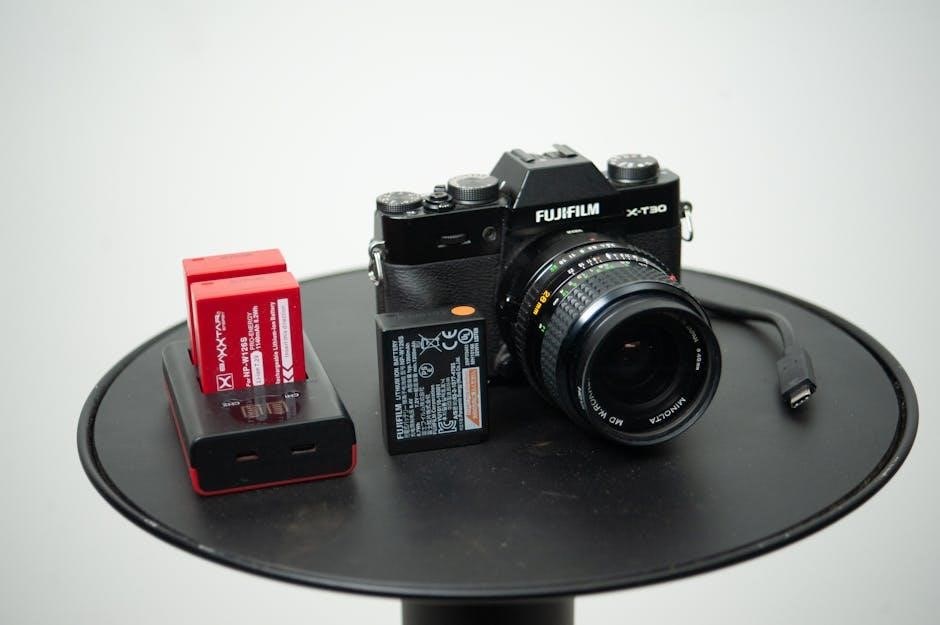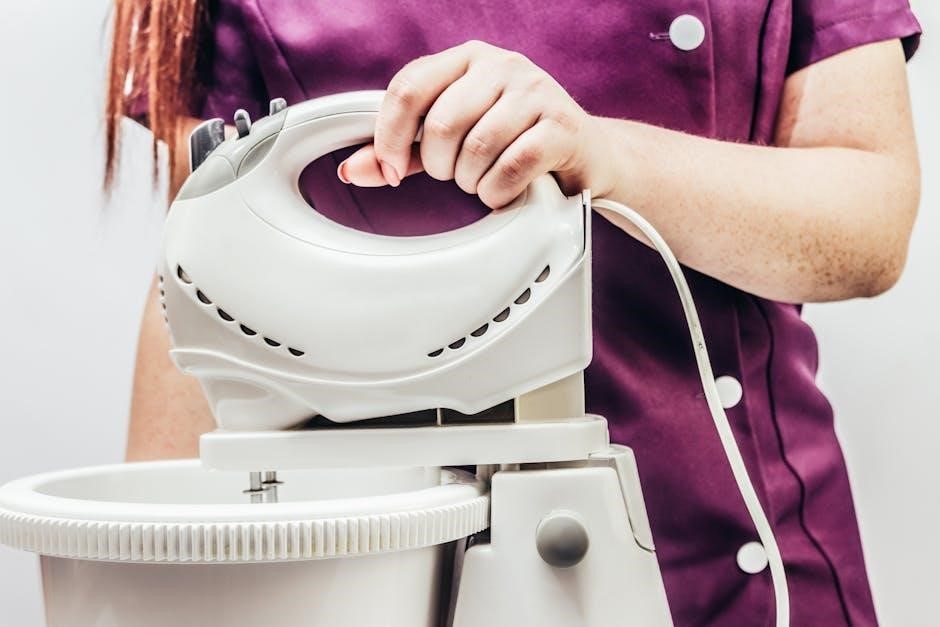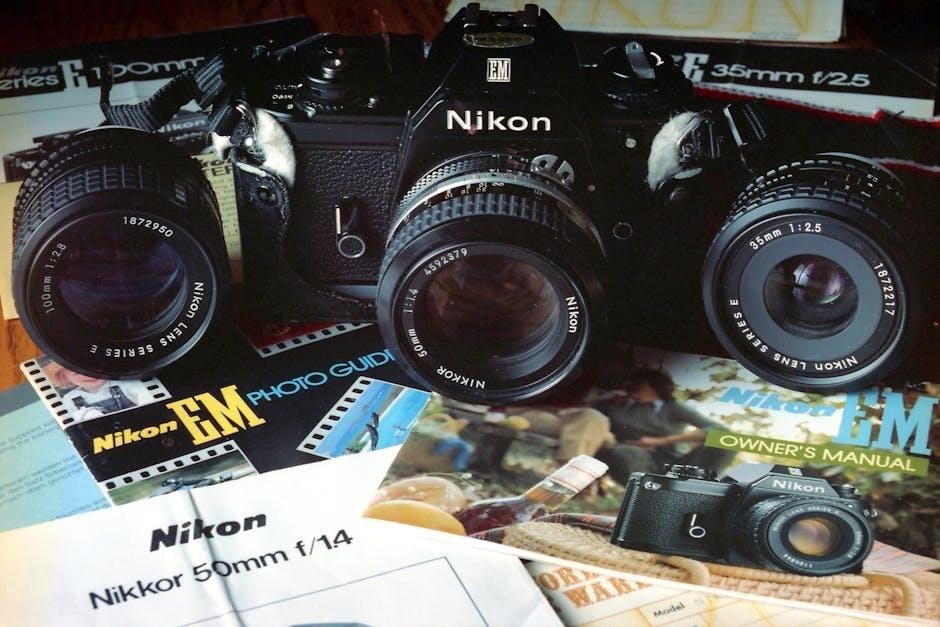Nikon D5200 Instruction Manual: A Comprehensive Guide
This comprehensive guide to the Nikon D5200 will cover everything from initial setup to advanced customization. Learn how to unlock your camera’s full potential and capture stunning images and videos‚ enhancing your photography journey.
The Nikon D5200 is a versatile DSLR designed for both enthusiastic beginners and seasoned photographers. Boasting a 24.1-megapixel CMOS sensor and EXPEED 3 image processor‚ it captures detailed images with excellent clarity and dynamic range. Its vari-angle LCD monitor allows for creative shooting angles‚ while the Full HD video recording capability ensures high-quality videos.
This instruction manual provides a step-by-step guide to understanding and utilizing the D5200’s features. From initial setup to advanced techniques‚ you’ll learn how to maximize your camera’s potential. Whether you’re exploring different shooting modes‚ adjusting settings for optimal performance‚ or troubleshooting common issues‚ this guide offers comprehensive support. Discover how to connect and share your photos‚ and delve into the world of Nikon’s Creative Lighting System. Prepare to unleash your creativity with the Nikon D5200.
Basic Camera Setup
Setting up your Nikon D5200 correctly is crucial for optimal performance. This section guides you through initial configurations‚ ensuring your camera is ready to capture stunning photos right out of the box.
Initial Settings: Language and Display Brightness
The first step in preparing your Nikon D5200 for use involves configuring initial settings. These settings include selecting your preferred language for the menu system and adjusting the display brightness to suit your viewing conditions. These adjustments are essential for a comfortable user experience.
To set the language‚ navigate to the setup menu and choose the language option. Select your desired language from the list. Next‚ adjust the display brightness to ensure optimal visibility. A well-adjusted display will allow for a clear view of the scene.
Properly configuring these initial settings ensures that you can easily navigate the camera’s menu system and view images clearly‚ regardless of the surrounding lighting conditions. This sets the foundation for a seamless and enjoyable photography experience with your Nikon D5200.
Understanding the Menu System
Navigating the Nikon D5200’s menu system is crucial for accessing and controlling the camera’s vast array of features. The menu is logically organized into sections‚ including playback‚ shooting‚ setup‚ retouch‚ and recent settings. Each section contains a range of options for customizing camera behavior.
The playback menu allows reviewing and managing captured images. The shooting menu controls image quality‚ ISO settings‚ white balance‚ and shooting mode. The setup menu handles general camera settings‚ date/time‚ and language. The retouch menu provides in-camera editing options.
Familiarizing yourself with the menu layout enables quick and efficient adjustments to camera settings‚ optimizing performance for various shooting scenarios. Spend time exploring each section to gain a deeper understanding of the D5200’s capabilities. This will significantly improve your photography workflow.

Shooting Modes and Settings
Explore the D5200’s shooting modes to match your creative vision. Master settings like aperture‚ shutter speed‚ and ISO for perfectly exposed‚ artistic photos‚ and unlock the camera’s full potential today.
Exploring Different Shooting Modes (Auto‚ Scene‚ Manual)
The Nikon D5200 offers a range of shooting modes to cater to various skill levels and photographic scenarios. The Auto mode simplifies the process‚ automatically adjusting settings for optimal results in diverse conditions. Scene modes provide pre-programmed settings tailored for specific situations like portrait‚ landscape‚ and sports‚ ensuring the best possible outcome with minimal effort.
For experienced users seeking creative control‚ the Manual mode allows complete command over aperture‚ shutter speed‚ and ISO‚ enabling precise adjustments to achieve desired effects. Aperture priority mode lets you control depth of field‚ while shutter priority mode allows you to control motion blur.
Understanding these different shooting modes unlocks the full potential of your Nikon D5200‚ empowering you to capture stunning images in any situation. Experiment with each mode to discover its capabilities and find the perfect setting for your unique style.
Adjusting White Balance and Exposure Compensation
White balance and exposure compensation are crucial settings for achieving accurate colors and proper brightness in your photos. White balance corrects color casts caused by different lighting conditions‚ ensuring that whites appear white and colors are true to life. The Nikon D5200 offers various white balance presets‚ such as daylight‚ shade‚ and fluorescent‚ as well as a custom setting for precise adjustments.
Exposure compensation allows you to fine-tune the overall brightness of your images. If your photos are consistently too bright or too dark‚ adjusting the exposure compensation can help you achieve the desired result. It’s particularly useful in challenging lighting situations where the camera’s meter may be fooled.
Mastering white balance and exposure compensation will significantly improve the quality of your photos‚ allowing you to capture scenes with accurate colors and perfect brightness. Experiment with these settings to understand their impact and develop your own unique style.

Advanced Features and Customization
Explore the advanced features of the Nikon D5200‚ including creative lighting and custom settings. Optimize your camera for peak performance to unlock its full creative potential for stunning results.
Utilizing the Nikon Creative Lighting System
The Nikon Creative Lighting System (CLS) offers extensive possibilities for enhancing your photography with controlled lighting. The D5200 supports CLS‚ enabling wireless flash control for creative effects. Understanding and utilizing CLS can significantly improve your images‚ especially in challenging lighting conditions.
To get started with CLS‚ familiarize yourself with the D5200’s built-in flash commander mode. This allows you to control compatible external flash units wirelessly. Experiment with different flash positions and power levels to achieve various lighting effects. You can use multiple flash units to create complex lighting setups‚ adding depth and dimension to your photos.
Consider investing in Nikon Speedlights (external flash units) that are CLS-compatible. These units offer more power and features compared to the built-in flash. Explore techniques such as bouncing flash off ceilings or walls to create softer‚ more natural-looking light. Mastering CLS opens up a world of creative possibilities‚ allowing you to craft your desired lighting for stunning images.
Customizing Camera Settings for Optimal Performance
The Nikon D5200 offers a range of customizable settings that allow you to tailor the camera to your specific shooting style and preferences. Taking the time to customize these settings can significantly enhance your shooting experience and improve the quality of your images. Start by exploring the menu system and identifying the settings that are most relevant to your needs.
One important area to customize is the autofocus system. Experiment with different AF-area modes to find the one that works best for your subject matter. Adjust the ISO settings to balance image quality and noise levels. Also‚ customize the button layout to make frequently used functions more accessible.
Furthermore‚ explore the image quality settings. Choose the optimal resolution and file format for your needs. Consider using RAW format for maximum flexibility in post-processing. Finally‚ fine-tune the color settings to achieve your desired look. By carefully customizing your camera settings‚ you can unlock the full potential of the D5200 and create stunning images that reflect your unique vision.

Troubleshooting and Maintenance
This section addresses common issues encountered with the Nikon D5200 and their solutions. Also‚ we will cover essential maintenance tips to prolong your camera’s lifespan.
Common Issues and Solutions
The Nikon D5200‚ while a reliable camera‚ may encounter some common issues. Addressing these promptly can save time and frustration. One frequent problem is blurry images‚ often caused by incorrect focus or slow shutter speeds. Ensure proper focus settings are selected and use a tripod in low-light conditions. Another issue is underexposed or overexposed photos‚ which can be rectified by adjusting the exposure compensation.
Err messages might appear due to lens communication problems. Clean the lens contacts and camera mount to resolve this. Additionally‚ battery drain can be an issue‚ particularly in cold weather; Use a fully charged‚ genuine Nikon battery and avoid excessive LCD use. If your photos have color casts‚ adjust the white balance settings to match the lighting conditions. Regularly updating your camera’s firmware can also fix many software-related problems and enhance overall performance. By understanding these common issues and solutions‚ you can ensure a smoother and more enjoyable photography experience with your Nikon D5200.
Cleaning and Storing Your Nikon D5200
Proper cleaning and storage are essential for maintaining the longevity and performance of your Nikon D5200. Before cleaning‚ always turn off the camera and remove the lens. Use a soft‚ dry microfiber cloth to gently wipe the camera body and lens surfaces‚ removing dust and fingerprints. For stubborn smudges‚ lightly dampen the cloth with lens cleaning solution‚ avoiding excessive moisture.
To clean the image sensor‚ use a blower to remove loose particles. If necessary‚ consider a professional sensor cleaning service. When storing your D5200‚ choose a cool‚ dry place away from direct sunlight and humidity. Use a camera bag or case with adequate padding to protect it from impacts. Remove the battery before long-term storage to prevent corrosion. Silica gel packets can help absorb moisture. By following these cleaning and storage guidelines‚ you’ll keep your Nikon D5200 in optimal condition for years to come‚ ready to capture your photographic adventures.

Connecting and Sharing
Learn how to connect your Nikon D5200 to your computer for easy photo transfer and explore the Nikon Manual Viewer app for convenient access to camera documentation and enhanced sharing options.
Transferring Photos to Your Computer
Transferring your cherished photos from your Nikon D5200 to your computer is a crucial step in preserving and sharing your memories. This process allows you to edit‚ organize‚ and back up your images for safekeeping. There are several methods to achieve this‚ each offering its own advantages.
One common method involves using a USB cable to directly connect your camera to your computer. Once connected‚ your computer should recognize the D5200 as an external storage device‚ allowing you to drag and drop files or use dedicated software like Nikon Transfer. This software often provides additional features like automatic renaming and folder organization.
Alternatively‚ you can remove the memory card from your camera and insert it into a card reader connected to your computer. This method can be faster than using a USB cable‚ especially with larger files. Ensure your card reader is compatible with the type of memory card used in your D5200. Regardless of the method you choose‚ always safely eject the camera or card reader from your computer before disconnecting it to prevent data corruption.
Using the Nikon Manual Viewer App
The Nikon Manual Viewer App is a convenient and eco-friendly alternative to carrying around a physical instruction manual for your D5200. This app provides access to a digital version of the manual directly on your smartphone or tablet‚ ensuring you always have the information you need at your fingertips. Available for both iOS and Android devices‚ the app allows you to download the manual for offline viewing‚ making it accessible even without an internet connection.
The Nikon Manual Viewer App boasts a user-friendly interface that makes navigating the manual a breeze. You can easily search for specific topics using keywords or browse through the table of contents. The app also includes helpful diagrams and illustrations to aid in understanding complex features and settings. With the Nikon Manual Viewer App‚ you can quickly find answers to your questions‚ troubleshoot issues‚ and master the full range of capabilities offered by your Nikon D5200‚ all while reducing paper waste.
